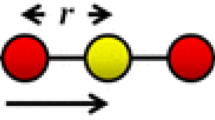Abstract
It has been observed that the long time evolution of a cellular automata (CA) can generate fractal sets. In this paper, we define a broad class of CA, all of which have a limit set. Moreover, we present an algorithm which associates with a CA of the above defined class a substitution system which deciphers the self-similarity structure of the limit set.
Similar content being viewed by others
Explore related subjects
Discover the latest articles, news and stories from top researchers in related subjects.References
J.-P. Allouche, Finite automata in 1-D and 2-D physics, in:Number Theory of Physics, ed. J.-M. Lucu, P. Moussa and M. Waldschmidt.
T. Bedford, Dynamics and dimension for fractal recurrent sets, J. London Math. Soc. 33(1986) 89–100.
F.M. Dekking, Recurrent sets, Adv. Math. 44(1982)78–104.
F.M. Dekking, Substitutions, branching processes and fractal sets, in:Fractal Geometry and Analysis, ed. J. Belair and S. Dubuc (Kluwer, 1991).
F. v. Haeseler, H.-O, Peitgen and G. Skordev, Pascal's triangle, dynamical systems, and attractors, Ergodic Theory and Dynamical Systems 12(1992)479–486.
F. v. Haeseler, H.-O, Peitgen and G. Skordev, Linear cellular automata, substitutions, hierarchical iterated function systems and attractors, in:Fractal Geometry and Computer Graphics, ed. J.L. Encarnacao, H.-O. Peitgen, G. Sakas and G. Englert (Springer, Heidelberg, 1992).
F. v. Haeseler, H.-O. Peitgen and G. Skordev, On the fractal structure of limit sets of cellular automata and attractors of dynamical systems, submitted.
G. Hedlund, Endomorphisms and automorphisms of the shift dynamical systems, Math. Syst. Th. 3(1969)320–375.
B. Mandelbrot,The Fractal Geometry of Nature (Freeman, New York, 1982).
B. Mandelbrot, Y. Gefen, A. Aharony and J. Peyriere, Fractals, their transfer matrices and their eigen-dimensional sequences, J. Phys. A: Math. Gen. 18(1985)335–354.
M. Queffelec,Substitutional Dynamical Systems, Lecture Notes in Math. 1294 (Springer, 1987).
J. Shallit and J. Stolfi, Two methods for generating fractals, Comp. Graphics 13(1989)185–191.
S. Takahashi, Cellular automata and multifractals: dimension spectra of linear cellular automata, Physica D45(1990)36–48.
S. Takahashi, Self-similarity of linear cellular automata, J. Comp. Sci. 44(1992)114–140.
S. Willson, Cellular automata can generate fractals, Discr. Appl. Math. 8(1984)91–99.
S. Willson, The equality of fractional dimension for certain cellular automata, Physica D24(1987) 179–189.
S. Willson, Computing fractal dimensions for additive cellular automata, Physica D24(1987) 190–206.
S. Wolfram, Statistical mechanics and cellular automata, Rev. Mod. Phys. 55(1983)601–644.
S. Wolfram, Universality and complexity in cellular automata, Physica D10(1984)1–35.
Author information
Authors and Affiliations
Additional information
Supported by DFG “Forschungsgruppe Dynamische Systems”.
Rights and permissions
About this article
Cite this article
Haeseler, F.v., Peitgen, H.O. & Skordev, G. Cellular automata, matrix substitutions and fractals. Ann Math Artif Intell 8, 345–362 (1993). https://doi.org/10.1007/BF01530797
Issue Date:
DOI: https://doi.org/10.1007/BF01530797




